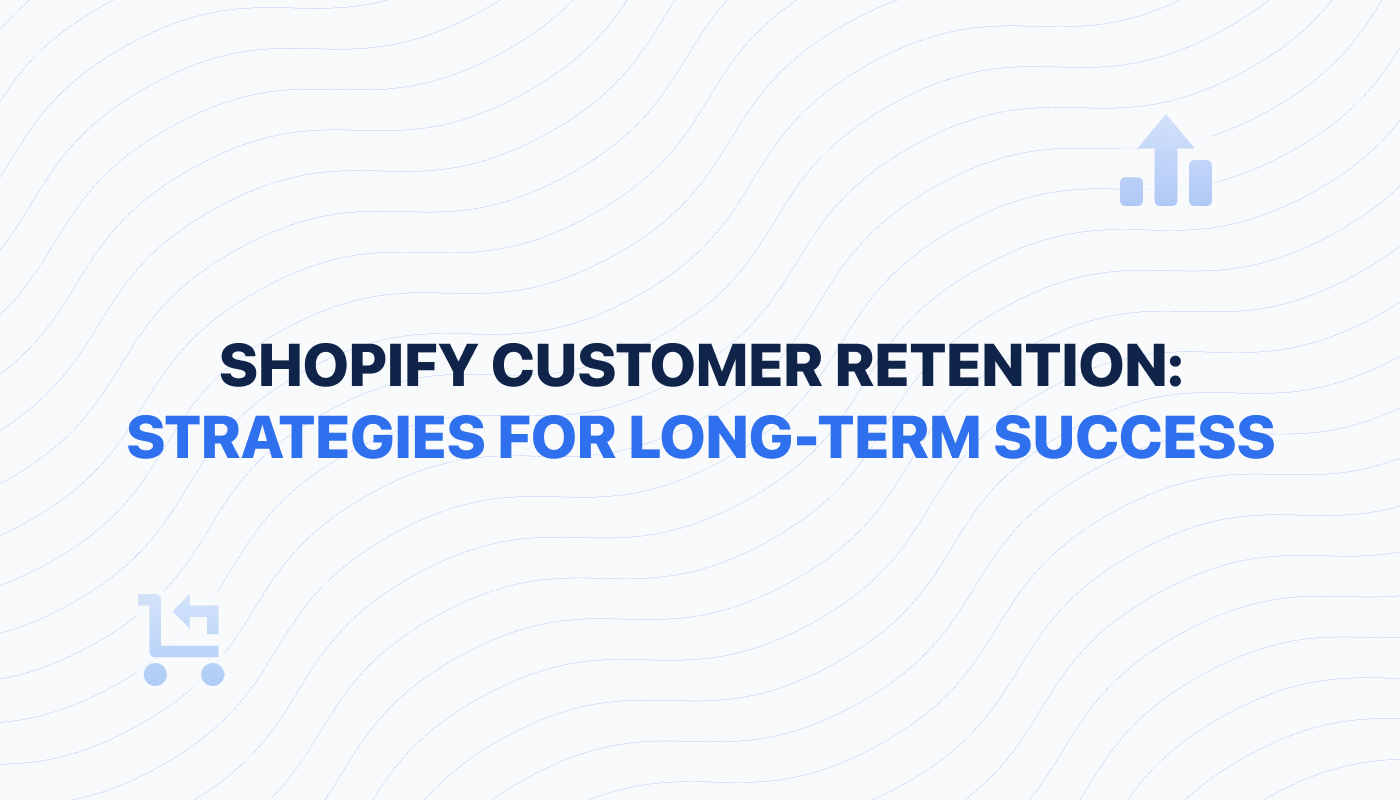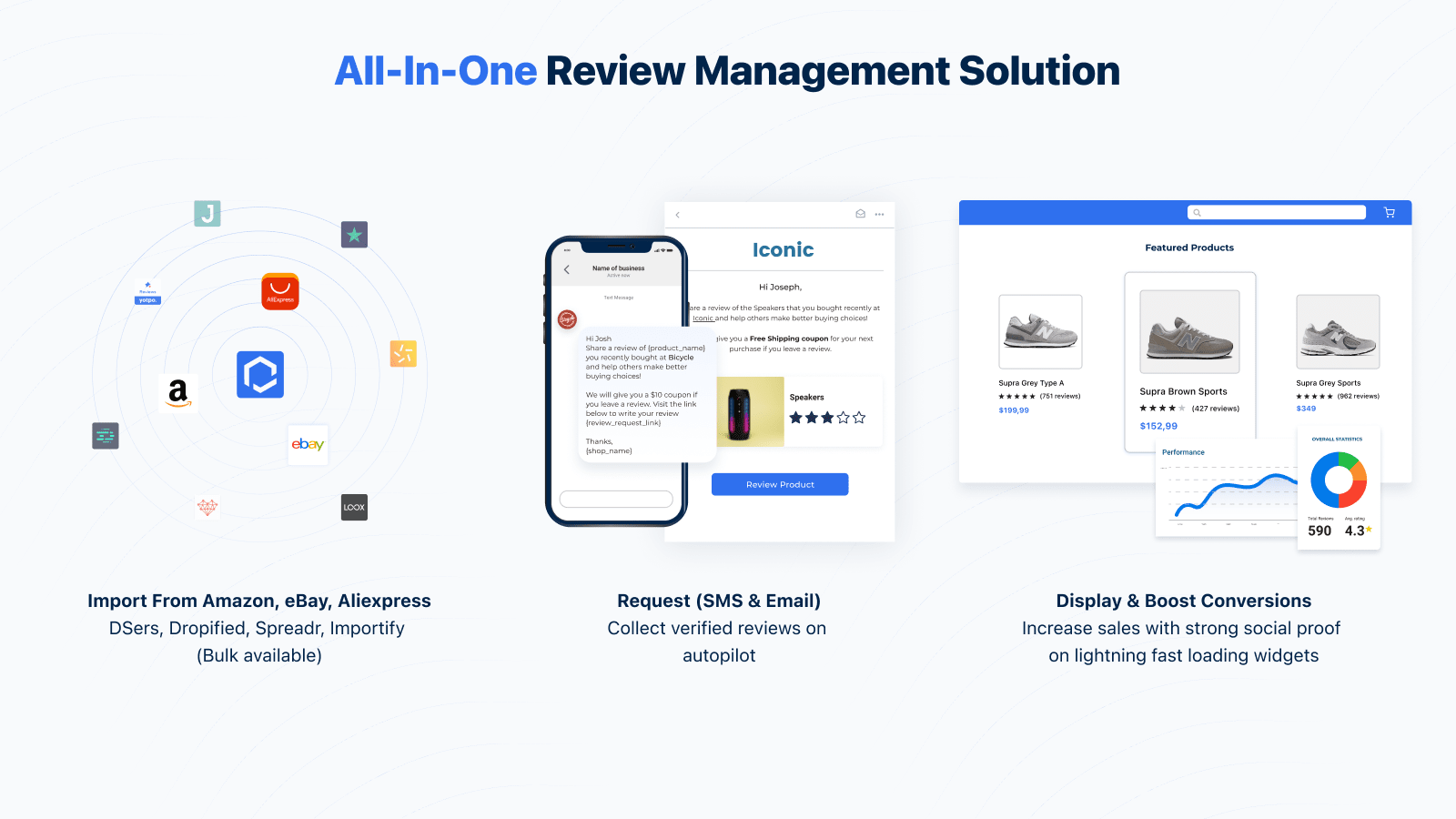
Shopify Customer Retention: Best Retention Strategies for Long-term Success!
Table of Contents
In the fiercely competitive realm of online business, a vital key to long-term success and profitability lies in customer retention.
According to Survey Sparrow, the top five players on the market have an average customer retention rate of 94%. Evidently, the ability to keep customers coming back is the elusive secret ingredient that propels these businesses to unparalleled heights.
Given the paramount significance of customer retention, it becomes inevitable for every Shopify retailer to master the art of retaining their valuable clientele.
In this article, you'll have the knowledge and tools to transform one-time buyers into lifelong customers, ensuring your Shopify store remains at the forefront of the e-commerce game.
Understanding Customer Behaviour
Understanding customer behaviour is crucial for effective Shopify customer retention. Businesses can Carefully analyze this dataset to tailor their strategies and provide better customer experiences.
By gaining insights into how customers think, behave, and make purchasing decisions, businesses can meet customer needs, provide exceptional experiences, and build long-term customer relationships. This understanding is invaluable in driving customer satisfaction, loyalty, and business success.
Analyzing Customer Data and Purchase History
Analyzing customer data and the purchase history of Shopify provides valuable insights into customer behaviour, preferences, and trends. Here are some critical steps to effectively analyze customer data and purchase history:
- Gather relevant customer data from various sources, such as your website, eCommerce platform, CRM system, and other customer touchpoints. By doing so, you can ensure the data is accurate, complete, and properly organized for analysis.
- Determine the key metrics and performance indicators (KPIs) aligning with your business goals and objectives. You can use KPIs like customer lifetime value (CLV), average order value (AOV), customer acquisition cost (CAC), purchase frequency, and customer retention rate.
- Analyze purchase frequency, recency, and monetary value to understand customer segmentation and prioritize marketing efforts.
Identifying Customer Preferences and Patterns
By understanding what customers prefer and how they behave, businesses can optimize their products and services to meet customer needs more effectively. Here are some steps to identify customer preferences and patterns:
- Examine customer purchase history data to identify patterns in product preferences, popular categories, and frequently purchased items.
- Use web analytics tools to analyze metrics to gain insights into customer preferences and engagement patterns. Measure click-through rates, page views, time spent on specific pages, and conversion rates.
- Segment your customer base based on relevant criteria such as demographics, purchase history, or psychographic factors.
Building Strong Customer Relationships
Building strong customer relationships is a crucial factor in fostering customer loyalty. Not only does it strengthen customer retention, but it also drives long-term business success for Shopify businesses.
By nurturing customer relationships, Shopify businesses can create a loyal customer base that advocates for their brand and contributes to sustainable growth.
Here are some strategies for building strong customer relationships:
Providing Exceptional Customer Service
Customers who receive outstanding service are more likely to remain connected, make repeat purchases, and recommend your business to others. Here are some strategies to provide exceptional customer service:
- To enhance customer service, prioritize comprehensive training programs to equip representatives with essential skills. These skills encompass active listening, problem-solving, empathy, conflict-resolution techniques, as well as knowledge of tools to assist customers effectively.
- Introduce multiple channels for customers to reach out for support, such as phone, email, live chat, social media, and helpdesk systems of fulfilment companies.
- Respond promptly to customer inquiries and issues. Customer responsiveness ensures that no request or concern goes unanswered, and regularly reviews and improves customer service processes based on feedback and performance metrics.
Personalizing The Shopping Experience
By creating a personalized experience, Shopify businesses can enhance customer satisfaction, increase engagement, and drive conversion rates. Here are some strategies to personalize the shopping experience:
- Use website personalization techniques to deliver customized content, product recommendations, or promotional messages based on customer data and browsing behaviour.
- Track customer behaviour and interactions to understand their preferences and interests.
- Leverage customer data to send personalized email campaigns based on customer preferences, purchase history, or browsing behaviour.
Implementing Loyalty Programs
Loyalty programs are tools for incentivizing repeat purchases, fostering customer loyalty, and increasing customer retention. By rewarding customers for their continued support, Shopify businesses can build stronger relationships and encourage long-term engagement.
Enlisted below are a few tips to help you implement loyalty programs for your Shopify customers:
- Determine the type of reward that resonates with your target audiences, such as discounts, freebies, exclusive access, or points-based systems.
- Implement tiered loyalty programs that increase benefits as customers move up the loyalty ladder.
- Incorporate gamification elements into the loyalty program to make it more engaging and interactive.
Effective Communication Strategies
Effective communication strategies play a crucial role in Shopify customer retention. One approach is to utilize email marketing campaigns to engage customers and keep them updated about new products, promotions, and personalized recommendations.
Shopify merchants can maintain a consistent and engaging dialogue with their customers by employing communication strategies. Ultimately increasing customer satisfaction and long-term retention.
Utilizing Email Marketing Campaigns
Email marketing campaigns are a powerful tool for communicating with customers, nurturing relationships, and driving engagement. Here are some email delivery strategies for effectively utilizing email marketing campaigns:
- First, segment your email list based on customer demographics, preferences, purchase history, or engagement level.
- Create attention-grabbing subject lines that entice recipients to open your emails. To write high-performing subject lines, keep them concise, personalized, and focused on the value or benefit that the email provides.
- Include clear and compelling CTAs that encourage recipients to take the desired action. This action can be anything, such as making a purchase, registering for an event, signing up for a newsletter, or downloading a resource.
Engaging Customers Through Social Media
Social media platforms allow Shopify businesses to engage with customers directly, build brand awareness, and foster a sense of community.
Here are some strategies for effectively Shopify engaging customers through social media:
- Identify the social media platforms suitable for your target audience and ascertain where they are most engaged.
- Develop high-quality and engaging content that resonates with your target audience. Use a mix of visuals, videos, articles, infographics, and user-generated content to keep the content fresh and diverse.
- Encourage users to actively engage with your content by asking questions, inviting comments, or running contests or giveaways. Moreover, address users by name, respond to comments or messages personally, and acknowledge their contributions.
Sending Personalized Follow-Up Messages
Personalized follow-up messages are a powerful way to deepen customer relationships, demonstrate appreciation, and drive engagement.
Here are some tried-and-tested tips for effectively sending personalized follow-up messages:
- Send personalized thank-you messages.
- Set up order confirmation emails.
- Conduct post-purchase surveys.
- Send abandoned Cart Reminders.
- Optimize upselling and cross-selling offers.
- Send personalized birthday or anniversary messages.
- Set up personalized re-engagement emails.
- Send feedback and testimonial requests.
Enhancing Customer Engagement
Customer engagement is of utmost importance for Shopify customer retention. Engaging customers effectively helps foster a strong relationship between the business and its customers. This leads to increased loyalty and repeat purchases.
Customer engagement also provides opportunities to gather feedback, address concerns promptly, and showcase social proof, which builds trust and credibility.
Offering Relevant and Valuable Content
Offering relevant and valuable content is a powerful way to engage customers and keep them connected to your brand. You can establish yourself as a trusted, well-reputed source and maintain their engagement by providing information, resources, and entertainment that align with their interests and needs.
Here are some strategies for offering relevant and valuable content:
- Share expert tips, best practices, and how-to guides that help customers solve problems or enhance their knowledge.
- Use storytelling techniques to engage customers emotionally and create a memorable connection.
- Share success stories, customer testimonials, or behind-the-scenes content that showcases your brand's values and impact.
- Utilize customer data and browsing history to recommend personalized content according to their interests and past interactions.
- Implement recommendation engines or personalized content modules on your website or newsletters to deliver relevant content.
Creating Interactive and Memorable Experiences
Creating interactive and memorable experiences helps to captivate customers and foster deeper engagement.
Go beyond traditional transactional interactions and offer interactive elements. This way, you can print a lasting impression and build a solid emotional connection with your customers.
Here are 13 strategies for creating interactive and memorable experiences:
- Introduce intuitive elements to enhance engagement and enjoyment.
- Offer tailored suggestions based on individual preferences or behaviours.
- Enable users to contribute their own content, fostering a sense of ownership.
- Implement interactive features for customization or exploration.
- Organize real-time online events to engage and interact with the audience.
- Deliver outstanding support and assistance to create a positive experience.
- Incorporate various forms of media (images, videos, audio) for a richer experience.
- Solicit input from users and involve them in decision-making processes.
- Design campaigns that immerse customers in memorable brand experiences.
- Provide special privileges or incentives to reward and engage loyal users.
- Cultivate a sense of belonging and interaction within an online community.
- Integrate features that encourage engagement and interaction on social media platforms.
- Track and analyze data to assess the effectiveness of engagement strategies.
Improving Product and Service Quality
Ensuring customer satisfaction through top-notch products is pivotal in cultivating trust and contentment.
A company's commitment to consistently delivering exceptional offerings paves the way for a solid reputation, nurtures customer loyalty, and heightens the chances of repeat purchases. Consequently, this fosters improved customer retention rates, a testament to the company's ability to meet and surpass customer expectations.
Gathering and Acting Upon Customer Feedback
Customer feedback is crucial for understanding their needs, preferences, and satisfaction levels. With quality customer feedback and data, you can specify areas for improvement and make necessary adjustments to enhance your product and service quality.
Collect Quality Customer Feedback & Data
To collect quality data and gather customer feedback effectively, create surveys or feedback forms to collect structured customer feedback. You can also conduct one-on-one interviews or organize focus groups to gain in-depth insights into customer perspectives.
Acting Upon Customer Feedback
Acting upon customer feedback is crucial for Shopify sellers to enhance their products, services, and overall customer experience. Here are two key steps to effectively leverage customer feedback:
- Prioritize and Take Action
Identify critical areas for improvement based on customer feedback. Develop action plans to address the identified issues and implement necessary changes using this data.
- Communicate and Involve Customers
Keep customers informed about the actions you're taking based on their feedback. Moreover, share updates and improvements through newsletters, website announcements, or social media posts. This will show that you value the input of your customers and involve them wherever possible.
Addressing Customer Concerns and Complaints Promptly
Promptly addressing customer concerns and complaints is crucial for maintaining customer satisfaction and loyalty.
Here's how to handle customer concerns and complaints effectively:
- Active Listening: Listen attentively to customers when they express concerns or complaints.
- Swift Response: Respond to customer concerns and complaints as quickly as possible.
- Find Solutions: Offer options or alternatives to address their concerns and meet their expectations.
- Follow-Up: Ensure that the resolution meets their expectations and ask for feedback on handling their issue.
Retention Metrics and Analysis
Regularly analyzing customer retention metrics and KPIs allows you to make data-driven decisions. Perform a thorough analysis of crucial retention metrics like churn rate, lifetime value, repeat purchase rate, and average order value.
This empowers you to optimize retention strategies, improving customer loyalty and increasing customer retention for your Shopify store.
Tracking Customer Retention Rates
Tracking customer retention rates is essential for understanding how well you retain customers over time. It helps you gauge your retention strategies' effectiveness and identify improvement areas.
Here are three key metrics and methods for tracking customer retention rates:
- Customer Retention Rate (CRR): Calculate the ratio of shoppers who continue to do business with you over a specific period—typically on a monthly or annual basis. Here is the formula to calculate CRR:
CRR = [(CE-CN) / CS] x 100
CE represents the total number of customers at the conclusion of a specific period. CN denotes the count of new customers acquired during that period, while CS refers to the number of shoppers at the beginning of the same period. - Cohort Analysis: Divide your customers into cohorts based on their signup or acquisition date. Now analyze how different groups of customers behave and if there are significant differences in retention rates.
- Churn Rate: The churn rate measures the percentage of customers who discontinue their relationship with your business over a specific period.
Churn Rate = (Customers at the Start - Customers at the End) / Customers at the Start.
Evaluating Customer Lifetime Value (CLV):
Customer Lifetime Value (CLV) is a metric that estimates the total value a customer will bring to your business during their association with you. Evaluating CLV helps you understand the long-term profitability of your customers and make data-driven decisions.
Here's how to evaluate customer lifetime value:
CLV = [(average order value X average number of orders per year) * average customer lifespan]
Suppose, a business's average order value is $100, the average customer places two orders per year, and the average customer lifespan is five years. In that case, the business's CLV would be $10,000.
Once you have calculated CLV, you can use it to decide how to allocate resources. For example, if you know your CLV is high, investing more in marketing and customer service is wise. This will help attract and retain more customers, ultimately increasing your CLV.
Ongoing Customer Retention Strategies
Implementing ongoing customer retention strategies is essential for maintaining a loyal customer base on Shopify. It includes personalized relationships, exceptional customer service, regular engagement, and loyalty programs. These strategies foster loyalty, drive repeat purchases, and strengthen customer relationships.
Regularly Rewarding Loyal Customers
You can strengthen customer loyalty and increase retention by offering incentives, discounts, or exclusive benefits. Here are four ways to regularly reward loyal customers:
- Loyalty Programs: Implement a loyalty program that provides rewards, points, or tiers based on customer purchases or engagement.
- VIP Programs: Offer exclusive perks like personalized customer support, early access to sales, or special events.
- Surprise and Delight: Randomly select customers to receive special offers or exclusive experiences to create a positive and memorable impression.
- Social Media Contests and Giveaways: Encourage customers to participate and share your content for a chance to win exclusive prizes or discounts.
Continuously Optimizing the Customer Experience
You can create a positive impression and build long-term loyalty by continuously optimizing and enhancing the customer journey. Here are some strategies for continuously optimizing the customer experience:
- Customer Journey Mapping: Identify pain points, opportunities for improvement, and moments where you can exceed customer expectations.
- Personalization: Tailor product recommendations, marketing messages, and communications to match individual customer needs and interests.
- Seamless Omnichannel Experience: Ensure consistency and continuity across multiple channels (e.g., website, mobile app, physical store) to provide a seamless omnichannel experience.
- Streamlined Checkout Process: Offer guest checkout options, save customer information for future purchases, and provide multiple payment methods to enhance convenience.
Conclusion: Retain Your Shopify Customers for Long-term Success!
Securing long-term success on Shopify hinges on implementing effective customer retention strategies. Building personalized relationships, delivering exceptional customer service, fostering regular engagement, and establishing loyalty programs are paramount.
By prioritizing these aspects, businesses can forge strong customer bonds and cultivate loyalty. Investment in customer retention leads to repeat purchases and lays a solid foundation for growth and profitability. Therefore, prioritize customer retention and steer your Shopify store toward sustained success and prosperity.

Get started for free
All-in-one review management solution for Shopify stores looking to build trust and increase conversions.
Opinew Blog Newsletter
Join the newsletter to receive the latest updates in your inbox.






